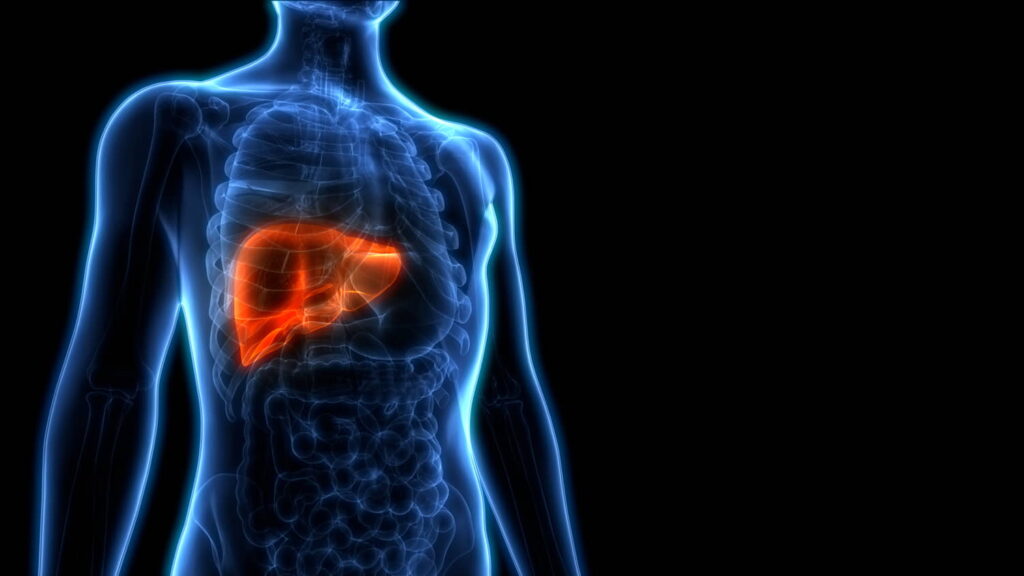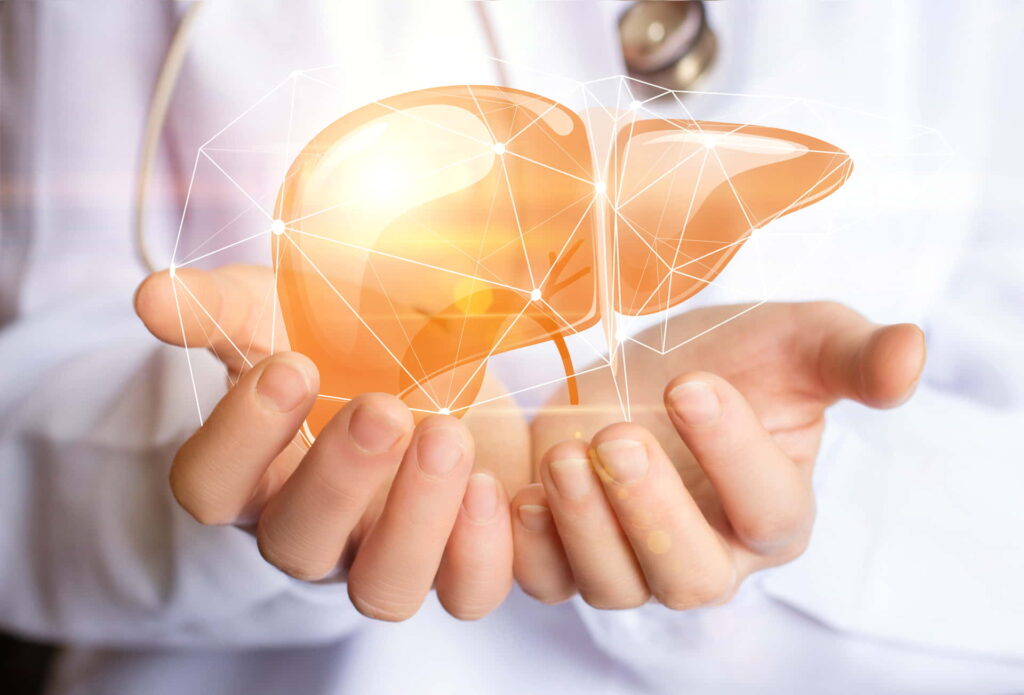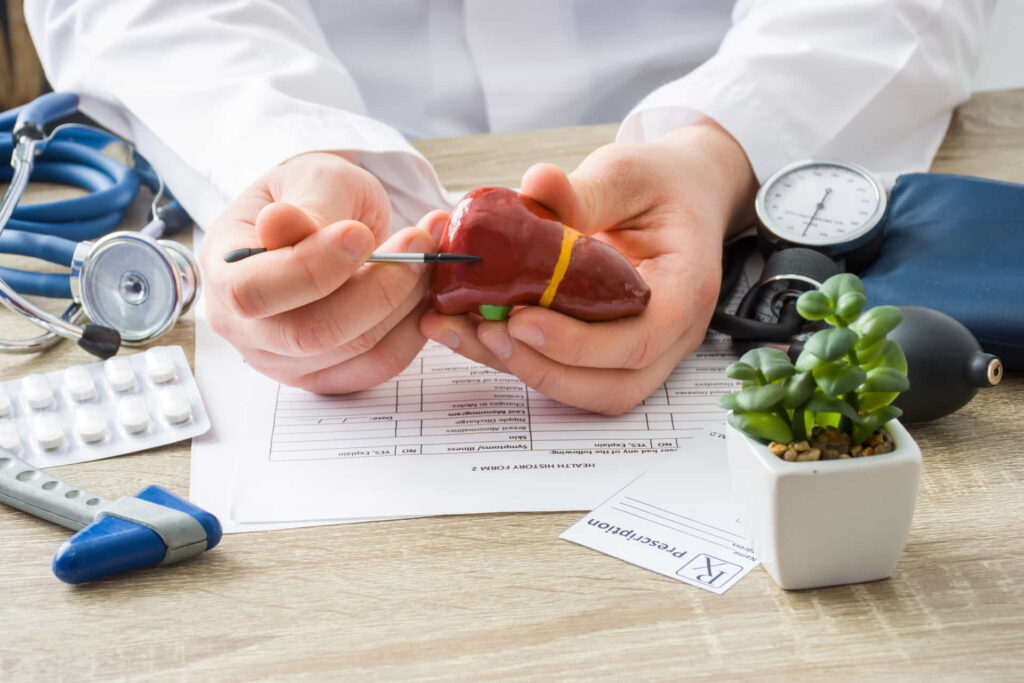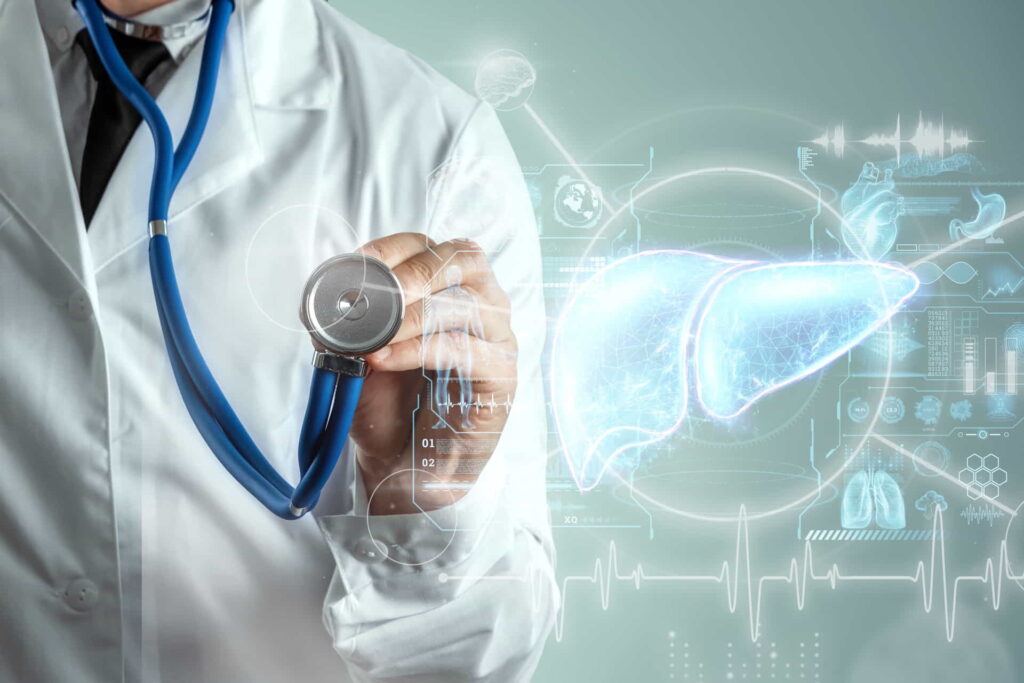
Liver Cancer
Understanding the causes and symptoms of liver cancer for effective treatment and prevention to improve the survival rate
Liver cancer is the third deadliest cancer in Hong Kong after lung cancer and colorectal cancer. It is associated with viral infections, environmental pollution, alcohol abuse, and consumption of mouldy food. Liver cancer can be divided into primary liver cancer and metastatic liver cancer. Liver cancer can be asymptomatic in the early stage. However, when the tumor becomes larger in the intermediate and advanced stages, the difficulty of treatment increases. The survival rate of liver cancer patients after treatment is highly dependent on the timing of detection and diagnosis. Therefore, it is recommended to seek medical advice if symptoms are observed.
The liver is an important organ in the human body and the only organ that can repair damage on its own. It is responsible for various important functions such as absorbing useful substances, detoxification, producing proteins, storing vitamins and minerals, and promoting red blood cell metabolism. If liver cells go through abnormal division and mutation, liver cancer will develop and severely affect the body.

According to the Hospital Authority, liver cancer ranks third among fatal cancers in Hong Kong. About 1,800 new cases of liver cancer are diagnosed each year, of which 75% are men and most are elderly. There are around 1,500 deaths every year, which is not far from the number of new cases. The latest government data show that the crude death rate per 100,000 population is 33.0 for men and 9.8 for women, while the age-standardized death rate per 100,000 population is 16.3 for men and 4.1 for women respectively. However, there has been a decreasing trend in the incidence and death rates of liver cancer over the past two decades. A study found that, among the 130 patients who underwent hepatectomy (liver resection) at the Queen Mary Hospital, the five-year survival rate for patients with stage I and II liver cancer was 60%, while the survival rate for patients with stage III and IV was lower, at only 30% for stage III and 10% for stage IV.
[Source: Hong Kong Anti-Cancer Society]
Symptoms of Liver Cancer
Liver cancer is prevalent in people aged between 50 to 70 years old, and its incidence rate in men is about four times that of women. As the liver has the ability to repair itself, it can function normally even when most areas have lost their functions. Therefore, early-stage liver cancer is usually asymptomatic, and only has the following possible symptoms upon reaching the intermediate and advanced stages:
- Abdominal swelling, hard lump in the upper right abdomen, pain near the shoulder blade.
- Ascites and sometimes visible blue veins on the abdomen
- Yellowing of the whites of the eyes, itchy skin
- Brown urine and light grey-coloured stools
- Prone to bleeding in injuries due to inadequate blood clotting factors
- Loss of appetite and unexplained weight loss
- Nausea and vomiting
- Fever and fatigue
The above symptoms are not exclusive to patients with liver cancer and may not be present in all liver cancer cases. If the above symptoms persist or even worsen, seek immediate medical advice to identify the cause.
Causes of Liver Cancer
The main causes of liver cancer are related to viral infections, environmental pollution, alcohol abuse, and consumption of moldy food. The following are common causes of liver cancer:
- Hepatitis B and C
Hepatitis B is an epidemic disease in Southeast Asia, and causes 55% of liver cancers worldwide. The hepatitis B carrier rate in Hong Kong has always been at a moderate to high level. Compared with normal people, hepatitis B patients have a 100-times higher chance of developing liver cancer, while hepatitis C patients even have a 150-times higher risk.
- Cirrhosis
When the liver is under long-term damage which exceeds its ability to recover, it enters the late stage of scarring which is called cirrhosis, and eventually develops into liver cancer.
- Consumption of mouldy food
Aflatoxins produced by mould in peanuts, grains, corn, soybeans and dried fruits can cause liver cancer.
- Various metabolic disease
The disorders include fatty liver disease, hyperlipidaemia (high cholesterol), hypertension (high blood pressure), hyperglycaemia (high blood sugar), low HDL cholesterol, etc. Metabolic disorders can damage the liver, which leads to cirrhosis and liver cancer.
- Environmental Pollution
Long-term exposure to harmful chemicals, such as polyvinyl chloride used in plastic factories.
- Alcohol Abuse
Excessive consumption of alcohol can lead to cirrhosis and result in liver cancer.
- Having cholangitis or congenital choledochal cysts may lead to cholangiocarcinoma
- Family medical history is also a factor. If a family member has had liver cancer, this may increase your risk of developing cancer
Survival Rate of Liver Cancer

Screening of Liver Cancer
If the patient is suspected of having liver cancer, the doctor will detect the possibility of liver cancer through routine examinations.
- Liver function test
A blood test can assess whether the liver can maintain normal function to determine if the patient is suitable for tumour removal surgery
- Alpha-fetoprotein (AFP) Tumour Marker Test
Alpha-fetoprotein is a tumour marker for liver cancer, therefore serves as an indicator for screening tests. An adult with a high AFP level in blood may indicate the presence of liver cancer.
Diagnosis of Liver Cancer
After an initial examination, if a patient is suspected of having liver cancer, doctors will use medical instruments to conduct a more comprehensive cancer diagnosis. Common methods include:
- Liver ultrasound scan
A device will be used to move across the liver area. It will emit ultrasound waves to the liver, then the reflected waves will be converted by a computer into an image to identify the size and location of the tumor.
- Computed Tomography (CT Scan)
Detailed cross-sectional images are taken to determine the size and location of the tumor.
- Magnetic Resonance Imaging (MRI)
A magnetic field is used to create a cross-sectional image of the body. This helps determine the location, size and possible malignancy of tumors, and to observe the condition of the soft tissues and blood vessels in the liver.
- Angiography
X-ray is used to observe the blood flow and identify the blood vessels that provide nutrients to the tumor, which helps to locate the tumor.
- Biopsy
A few tissues from the tumor are taken for laboratory examination to determine if the tumor is benign or malignant.
If metastatic cancer is diagnosed in the tests, additional tests such as bone scan and positron emission tomography (PET) scan will be conducted to determine the appropriate treatment plan for the patient.

Treatment of Pancreatic Cancer
The doctor will decide on the treatment plan according to the type of cancer cells, the size, number, location and metastatic status of the tumor, as well as the patient’s age, health condition and tolerance for side effects.
- Surgery
This is the most ideal and straightforward approach for cancer treatment. Doctors may consider local treatment to preserve the functional part of the liver if the patient is not suitable for resection. Surgery is suitable for patients with good liver function and early-stage liver cancer only in one of the two lobes.
- Ablation therapy
The area near the tumor will be heated to over 60 degrees Celsius to destroy the tumor tissue. It is suitable for early-stage primary liver cancer and metastatic liver cancer, and for patients with poor liver function who are unable to undergo surgical resection.
- Transarterial chemoembolization, TACE
The doctor will locate the blood vessel supplying nutrients to the tumor, and then inject drugs through an arterial catheter to block the vessel. This procedure blocks the growth of the tumor or even kills it without affecting the surrounding normal tissues. It is suitable for patients whose tumors have spread to both sides of the liver but have not metastasized to other organs.
- Radiotherapy
It can be divided into the conventional external beam radiotherapy and microsphere radioembolization, which involves injecting radioactive microspheres through the patient’s intravascular catheter into the hepatic artery of the tumor. The microspheres will then emit short-distance radiation that can eliminate cancer cells without overly damaging the normal liver function.
- Liver transplant
This treatment is suitable for patients with both liver cancer and cirrhosis as both conditions can be treated at the same time.
- Targeted Therapy
This treatment is suitable for patients with advanced liver cancer who are unable to receive surgical resection, ablation therapy, or TACE.
- Immunotherapy
Recent studies suggest that immunotherapy with PD-1 inhibitors is an effective second-line treatment for liver cancer. It blocks the binding of PD-L1 in tumor cells with PD-1 in immune cells, thus allowing our immune cells to recognize tumors as enemies and actively destroy the cancer cells. Different clinical studies are now using immunotherapy together with targeted therapy to enhance the therapeutic effect.

Recovery and Rehabilitation of Liver cancer
Upon completion of treatment, the patient's condition should be in remission. However, patients in recovery should also pay extra attention to their daily routine to ensure the best results of the treatment.
- Consume food rich in protein and vitamins, such as milk, eggs, fruits, and vegetables. Reduce the intake of animal oil.
- Refrain from tobacco and alcohol. Quit smoking and drinking as soon as possible.
- Arrange regular follow-up consultations and follow the doctor’s instructions. Seek immediate medical attention and receive appropriate treatment if you find any abnormalities.
- Maintain a cheerful or calm state of mind and communicate with family, friends and social workers, etc. if necessary.
Prevention of Liver Cancer
Since the early symptoms of liver cancer are not always obvious, regular check-ups are essential for early prevention. This is especially important for individuals carrying the hepatitis B virus, who should undergo regular follow-up and check-ups every year to reduce the risk of developing liver cancer. The following are methods for reducing the risk factors for liver cancer:
- Quit smoking and drink moderately
- Maintain a regular sleeping habit
- Eat more vegetables and fruits
- Receive a blood test to confirm the presence of antibodies if you have a family member with hepatitis B.
- Receive hepatitis B vaccine three times in six months.
- Take safety precautions before sexual intercourse
- Do not share syringes to avoid infection with hepatitis B or C through body fluids
- Store food in a dry place and do not consume mouldy or spoiled food
Lung Cancer FAQ
Q. Where does liver cancer spread?
If left untreated, liver cancer can spread to any part of the body. When liver cancer cells divide and grow, they usually first spread to the hepatic veins or the nearby lymph nodes; and then to distant organs such as the bones or lungs.
Q. Is liver cancer hereditary?
Liver cancer is rarely hereditary, but some inherited metabolic disorders increase the risk of cirrhosis, which is a common risk factor for liver cancer. For example, people with hereditary hemochromatosis absorb too much iron from their food. If enough iron accumulates in the liver, it may lead to cirrhosis and liver cancer.
Q. What does liver pain feel like?
Liver pain can appear in many different forms and vary according to the person's body type. Some people have reported the symptoms of a throbbing or tingling sensation, pain in the lower back or shoulders, and swelling that does not subside.
References
- Hong Kong Cancer Registry. https://www3.ha.org.hk/cancereg/pdf/overview/Overview%20of%20HK%20Cancer%20Stat%202018_tc.pdf . Accessed 30 June 2021.
- https://www.chp.gov.hk/tc/healthtopics/content/25/52.html
- https://www.cancer-fund.org/liver-cancer/



